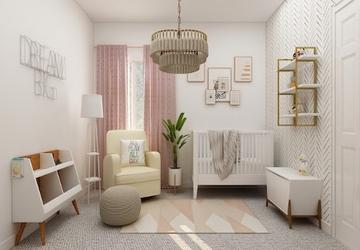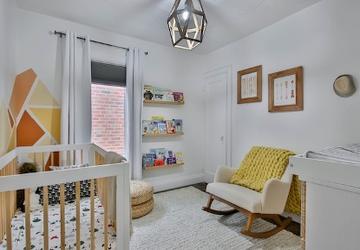Creating a safe environment for your infant is a top priority for every parent. As a responsible caregiver, you want to ensure that your little one has a nurturing and secure environment to grow and thrive.
In this comprehensive guide, we will provide you with valuable insights and practical tips for creating a safe and healthy child care setting. From selecting the right furniture to maintaining cleanliness and implementing safety measures, we will cover it all. Let's dive in and discover how to design a safe and healthy haven for your precious bundle of joy!
Planning the Nursery
Designing your baby's nursery is indeed exciting, especially or first-time parents. However, it also requires careful planning and consideration. It's essential to create a space that promotes comfort, stimulates their senses, and fosters their development. Here are some key factors to keep in mind to create a safe and healthy environment for child care:
Choosing the Ideal Location
Select a room that is easily accessible and close to your bedroom. This proximity will make nighttime feedings and diaper changes more convenient for you. Make sure that the room that you have chosen for your baby has adequate natural light and ventilation.
Paint and Color Scheme
When it comes to selecting paint colors, opt for non-toxic, low-VOC (volatile organic compounds) paints. These types of paints are eco-friendly and emit fewer harmful chemicals into the air, ensuring a healthier indoor environment for your baby. If you don’t want to choose the typical colors, i.e., soft blue for a baby boy and baby pink for a girl, you can look up other soft, soothing colors like pastels or neutrals. These are often preferred as they create a serene ambiance.
Selecting the Furniture
Investing in well-crafted and sturdy furniture is crucial for your baby's safety. Choose a crib that meets the current safety standards, has adjustable mattress heights, and sturdy side rails. Consider a convertible crib that can be transformed into a toddler bed as your child grows. Select a comfortable nursing chair, a changing table with ample storage, and a dresser to organize your baby's essentials.

Ensuring Safety
Maintaining a safe nursery environment is of utmost importance to protect your baby from potential hazards. You need implement safety measures to eliminate any risks to your baby and for the sake of your peace of mind. Here's what you need to focus on:
Crib Safety
Creating a safe and healthy child care setting entails that your baby's crib meets the safety standards set by organizations like the Consumer Product Safety Commission (CPSC). The crib should have a firm mattress that fits snugly, with no gaps between the mattress and the crib frame. Remove any pillows, stuffed animals, or heavy blankets from the crib to prevent suffocation hazards.
Electrical Safety
In terms of electrical safety, for a safe and healthy environment for child care, you need to secure all electrical cords out of reach and cover outlets with safety plugs or outlet covers. Use cord organizers to manage loose cords from lamps or electronic devices. Keep any electrical appliances away from the crib or any other areas accessible to your baby.
Baby-Proofing
You can start the baby-proofing process with baby gates. Baby gates should be installed at the top and bottom of stairs. Cover sharp corners of furniture with corner guards, and secure heavy furniture to the wall to prevent tipping accidents. Use safety latches on drawers and cabinets to keep hazardous substances out of your child's reach. Keep small objects and choking hazards away from the nursery.
Window Safety
Install cordless window coverings or use cord safety devices to prevent strangulation hazards. You should keep the baby’s crib and other furniture away from windows to avoid dangerous falls. Install window guards or window stops to limit the opening width and ensure proper ventilation.
Maintaining a Clean and Healthy Environment
By following these guidelines, you can create a pristine space that promotes good health:
Regular Cleaning
Dust and vacuum the nursery regularly to minimize allergens and dust mites. You should choose non-toxic cleaning products to make sure that the environment is safe for your little one. Clean the crib mattress regularly, following the manufacturer's instructions. Wipe down surfaces, such as the changing table, with a mild, baby-safe disinfectant. Launder bedding, curtains, and soft toys frequently to maintain cleanliness and reduce the risk of allergies or respiratory issues.
Air Quality
Promoting good air quality in the nursery is vital for your baby's respiratory health. Avoid smoking or exposing your baby to secondhand smoke. Keep the room well-ventilated by opening windows or using an air purifier to filter out dust, pollutants, and allergens. Be mindful of using scented products, as strong fragrances can irritate your baby's sensitive airways.
Temperature Control
It is critical to keep the nursery at a pleasant and safe temperature. Make sure the room isn't too hot or too cool. Monitor the temperature using a room thermometer and use a humidifier to keep the air moist, especially during dry seasons. Dress your baby appropriately for the temperature in the room to avoid overheating or chills.
Organizing and Personalizing the Nursery
Parents want to create a nursery that reflects their style, shows their love, and provides a nurturing atmosphere for their baby. Here are some tips to help you organize and personalize the space:
Storage Solutions
Invest in functional storage solutions to keep the nursery clutter-free. Use baskets, bins, and shelves to organize diapers, clothing, toys, and other baby essentials. Consider labeling containers to make it easier to find items when you need them.
Soft Lighting
Opt for soft, adjustable lighting options in the nursery. Use blackout curtains or blinds to create a conducive sleep environment during daytime naps. Install dimmer switches or use soft nightlights to provide a comforting glow during nighttime feedings or diaper changes.

Comfort and Sensory Stimulation
Incorporate elements that promote comfort and sensory development. Use soft, organic fabrics for bedding and blankets. Hang a baby-safe mirror to encourage self-recognition and visual stimulation. Provide a variety of age-appropriate toys and books to engage your baby's senses and encourage exploration.
Conclusion
Creating a safe environment for infants is an essential part of preparing for their arrival. By following these guidelines, you can design a nurturing space that prioritizes your baby's well-being. With proper planning and attention to detail, you can create a nursery that will support your baby's growth, development, and happiness.
Wishing you joy and success in this exciting journey of creating a safe and healthy child care setting and parenthood!
